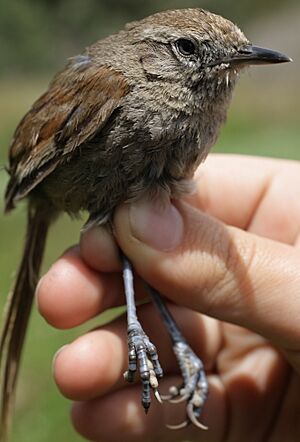Perijá thistletail facts for kids
Quick facts for kids Perijá thistletail |
|
|---|---|
 |
|
| Conservation status | |
| Scientific classification | |
| Genus: |
Asthenes
|
| Species: |
perijana
|
 |
|
| Synonyms | |
|
Schizoeaca perijana |
|
The Perijá thistletail (Asthenes perijana) is a special type of bird. It lives only in the Perijá Mountains which are located between Colombia and Venezuela. This bird is very rare and is listed as an Endangered species. It is part of the ovenbird family, called Furnariidae, known for their interesting nests.
Contents
How Scientists Classify This Bird
For a long time, scientists thought the Perijá thistletail was just a type of another bird, the white-chinned thistletail. But after more study, they realized it was its own unique species.
This bird and some others used to be in a group called Schizoeaca. However, new scientific tests showed they actually fit better within the Asthenes group. The Perijá thistletail is considered "monotypic," which means it does not have any subspecies.
What the Perijá Thistletail Looks Like
The Perijá thistletail is a small bird, about 19 to 22 centimeters (7.5 to 8.7 inches) long. It weighs around 16 to 21 grams (0.56 to 0.74 ounces). Both male and female birds look the same.
They have a faint grayish stripe above their eyes. Their head, back, and tail are a grayish olive-brown color. Their wings are also grayish olive-brown, but they have some chestnut (reddish-brown) color on the upper parts and near the base of their flight feathers.
Their tail is long and deeply split, looking a bit ragged at the ends. They have a cinnamon-buff (light reddish-brown) patch on their chin. The rest of their throat and belly are brownish-gray. Their eyes are reddish-brown, and their beak is black on top and grayish with a black tip on the bottom. Their legs and feet are gray.
Where the Perijá Thistletail Lives
This bird is found only in the Serranía del Perijá. This is a mountain range that forms part of the border between northeastern Colombia and northwestern Venezuela.
It prefers to live in certain types of high-altitude areas. These include páramo grasslands, which are special ecosystems found in the Andes. It also lives at the very top edge of cloudforests and in thick bushes where the trees start to thin out. You can find them at elevations between 2,950 and 3,400 meters (9,680 to 11,150 feet) above sea level.
Behavior of the Perijá Thistletail
Movement
Scientists believe that the Perijá thistletail stays in the same area all year round. It does not migrate to different places.
Feeding Habits
The Perijá thistletail mainly eats arthropods, which are creatures like insects and spiders. Sometimes, it also eats berries. It usually searches for food alone or in pairs, moving through the thick bushes and plants. It likely finds its food by picking prey off leaves and branches.
Reproduction
Not much is known about how the Perijá thistletail reproduces. We know that they breed in July, but the full breeding season is still a mystery. More research is needed to understand their nesting habits and how they raise their young.
Vocalization
The song of the Perijá thistletail is quite distinct. It starts with about three to five long, high-pitched "pee" notes. These are then followed by a short, dry, descending trill.
Status and Conservation
The IUCN (International Union for Conservation of Nature) first listed the Perijá thistletail as "Vulnerable." However, since 2004, its status has been changed to "Endangered." This means it faces a very high risk of becoming extinct in the wild.
The bird has a very small area where it lives. Its population is also very small, with an estimated 150 to 700 adult birds left. This number is believed to be getting smaller. The main threat to this bird is the loss of its habitat. Areas below 2,000 meters in the Sierra de Perijá are being changed by human activities.
Only small patches of mountain forest remain on the steepest slopes. The area where this bird lives is estimated to be about 110 square kilometers (42 square miles). There is one protected area in Colombia that helps, but protection in Venezuela's Sierra de Perijá National Park is not always strong. In Colombia, it is considered Endangered, and in Venezuela, it is considered Vulnerable.


